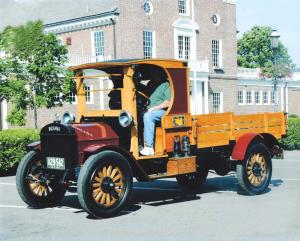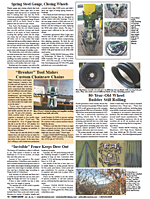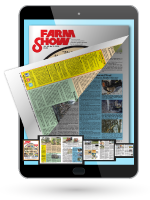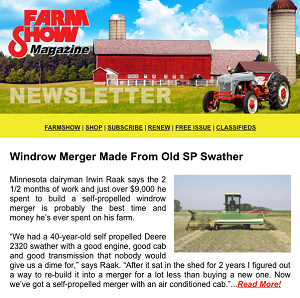1917 ‘Find Of A Lifetime’ Truck Is Fully Restored
 ✖  |
When Greg MacKenzie and a friend went to look at old vehicles in an abandoned Bronx barn, they had no idea what to expect. After fighting their way through overgrown brush, they found an Al Capone Buick, a 1920 Chevrolet and the broken-down remains of an Indiana Model T flatbed truck. Despite the Indiana’s unsightly condition, MacKenzie says it was “love at first sight.” During evenings and weekends over the next year, he and his wife brought the 1917 truck back to “show quality” condition.
“When I first saw it, the wooden cab, body and box were infested with termites, basically just a shade above sawdust,” MacKenzie says. “The windshield glass had broken because its frame had disintegrated. The tires were all flat, one of the 14-spoke wooden wheels was completely broken, and the vehicle was drab gray underneath the dust. When I got it home, my wife called it ‘one big pile of junk.’”
Despite that, MacKenzie knew his barn find was a rare vehicle, having survived nearly 100 years when most others like it were long gone. He’d learned that the first Indiana cargo truck was built in 1910, about 150 were made in 1913, and by 1917, the company had 1, 2, 3.5 and 5-ton models. The 1-ton model MacKenzie found has a Waukesha engine and rides on a 130-in. wheelbase. Top speed is about 20 mph. It had worked on a Maine vegetable farm until 1960, was sold to a New York collector, and then sat 40 years unattended in a Bronx barn with a leaking roof and rotted floors.
“When we dismantled the body, we carefully salvaged all the hardware. When we’d finished, my wife used a snow shovel to pick up the scrap wood pieces,” MacKenzie says. The metal chassis, springs, hood and fenders were in very good shape because they’d been painted. The engine turned over, and it wasn’t until we completed the whole body, and I drove it about a mile, spewing smoke everywhere, that I realized it needed overhauling. That was a big project, but it ran great after several new parts and fine-tuning.”
Rebuilding the cab and cargo box was nearly a year-long project, working nights and weekends. “We don’t have a lumber supplier nearby, so I made several trips to Home Depot, selecting the best oak pieces I could find. I used the photos and measurements I’d taken at the warehouse to build new parts. My wife sanded the paint off the old spokes and rims of three wheels, and we used a fly cutter to make new spokes and a rim for the other one. All the truck’s wood parts were finished with urethane varnish to reveal a rich oak color. The wheels were shod with new tires, and the metal components were cleaned, primed and painted. Sheet metal fenders and the hood were coated with deep red acrylic paint.
MacKenzie is a stickler for detail, so small feature items like the gauges, lanterns, taillights, metal fixtures in the cab, and the steering column were restored to a like new condition. Four vintage fuel containers and an antique wooden tool chest ride in the truck’s cargo box. Its metal side wall stakes, hinges and chain closures were all refinished. He also rebuilt the large fin radiator with the name “Indiana” inscribed on the top, adding a distinctive Boyce Moto-Meter to measure and display coolant temperature.
The driver’s compartment features a comfortable upholstered seat and a wood floorboard. It also has openings for the clutch, accelerator, brake pedals and a foot-operated exhaust cutout that allows the car to bypass the muffler for more power.
Two distinctive finishing touches include a service sign on both sides of the box and metal footplates with “Indiana Motor Trucks” lettering on both running boards. He also installed a period-correct spotlight on the upper right column of the cab.
MacKenzie says that the Harwood-Barley Company, which built the Indiana models, was one of about 200 companies building trucks in the early 1900s. Their vehicles are now highly valued by collectors. An advertisement for a truck like MacKenzie’s boasted that it would replace 14 teams of horses, hauling a ton of carriage for 6.75 cents a mile.
“The thick leaf springs and heavy-duty cargo box on my truck would definitely haul a ton or more,” MacKenzie says, “but this one only goes to parades and shows. At one event, I described how we restored it and mentioned there aren’t many in existence. A fellow behind me overheard our conversation and said his father had one very similar. It’s a classy vehicle and was definitely worth the time it took to restore.”
Contact: FARM SHOW Followup, Greg MacKenzie, 14 Mead Place, Rye, N.Y. 10580.

Click here to download page story appeared in.
Click here to read entire issue
1917 ‘Find Of A Lifetime’ Truck Is Fully Restored TRACTORS Collectors When Greg MacKenzie and a friend went to look at old vehicles in an abandoned Bronx barn they had no idea what to expect After fighting their way through overgrown brush they found an Al Capone Buick a 1920 Chevrolet and the broken-down remains of an Indiana Model T flatbed truck Despite the Indiana’s unsightly condition MacKenzie says it was “love at first sight ” During evenings and weekends over the next year he and his wife brought the 1917 truck back to “show quality” condition “When I first saw it the wooden cab body and box were infested with termites basically just a shade above sawdust ” MacKenzie says “The windshield glass had broken because its frame had disintegrated The tires were all flat one of the 14-spoke wooden wheels was completely broken and the vehicle was drab gray underneath the dust When I got it home my wife called it ‘one big pile of junk ’” Despite that MacKenzie knew his barn find was a rare vehicle having survived nearly 100 years when most others like it were long gone He’d learned that the first Indiana cargo truck was built in 1910 about 150 were made in 1913 and by 1917 the company had 1 2 3 5 and 5-ton models The 1-ton model MacKenzie found has a Waukesha engine and rides on a 130-in wheelbase Top speed is about 20 mph It had worked on a Maine vegetable farm until 1960 was sold to a New York collector and then sat 40 years unattended in a Bronx barn with a leaking roof and rotted floors “When we dismantled the body we carefully salvaged all the hardware When we’d finished my wife used a snow shovel to pick up the scrap wood pieces ” MacKenzie says The metal chassis springs hood and fenders were in very good shape because they’d been painted The engine turned over and it wasn’t until we completed the whole body and I drove it about a mile spewing smoke everywhere that I realized it needed overhauling That was a big project but it ran great after several new parts and fine-tuning ” Rebuilding the cab and cargo box was nearly a year-long project working nights and weekends “We don’t have a lumber supplier nearby so I made several trips to Home Depot selecting the best oak pieces I could find I used the photos and measurements I’d taken at the warehouse to build new parts My wife sanded the paint off the old spokes and rims of three wheels and we used a fly cutter to make new spokes and a rim for the other one All the truck’s wood parts were finished with urethane varnish to reveal a rich oak color The wheels were shod with new tires and the metal components were cleaned primed and painted Sheet metal fenders and the hood were coated with deep red acrylic paint MacKenzie is a stickler for detail so small feature items like the gauges lanterns taillights metal fixtures in the cab and the steering column were restored to a like new condition Four vintage fuel containers and an antique wooden tool chest ride in the truck’s cargo box Its metal side wall stakes hinges and chain closures were all refinished He also rebuilt the large fin radiator with the name “Indiana” inscribed on the top adding a distinctive Boyce Moto-Meter to measure and display coolant temperature The driver’s compartment features a comfortable upholstered seat and a wood floorboard It also has openings for the clutch accelerator brake pedals and a foot-operated exhaust cutout that allows the car to bypass the muffler for more power Two distinctive finishing touches include a service sign on both sides of the box and metal footplates with “Indiana Motor Trucks” lettering on both running boards He also installed a period-correct spotlight on the upper right column of the cab MacKenzie says that the Harwood-Barley Company which built the Indiana models was one of about 200 companies building trucks in the early 1900s Their vehicles are now highly valued by collectors An advertisement for a truck like MacKenzie’s boasted that it would replace 14 teams of horses hauling a ton of carriage for 6 75 cents a mile “The thick leaf springs and heavy-duty cargo box on my truck would definitely haul a ton or more ” MacKenzie says “but this one only goes to parades and shows At one event I described how we restored it and mentioned there aren’t many in existence A fellow behind me overheard our conversation and said his father had one very similar It’s a classy vehicle and was definitely worth the time it took to restore ” Contact: FARM SHOW Followup Greg MacKenzie 14 Mead Place Rye N Y 10580
To read the rest of this story, download this issue below or click
here to register with your account number.







